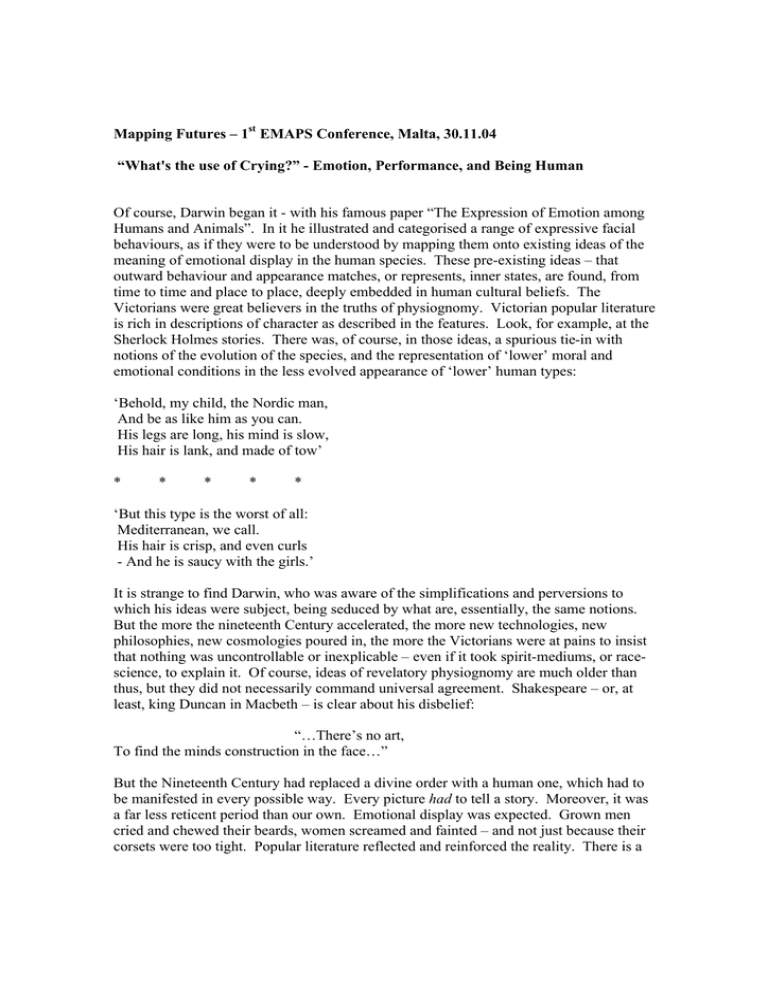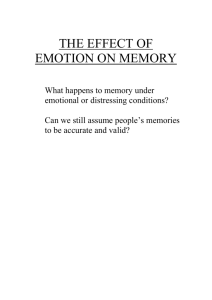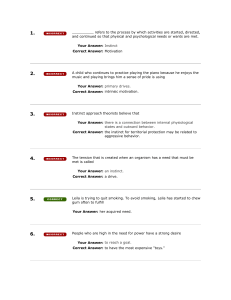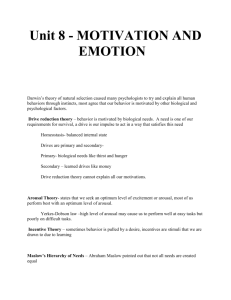Mapping Futures – 1 EMAPS Conference, Malta, 30.11.04
advertisement

Mapping Futures – 1st EMAPS Conference, Malta, 30.11.04 “What's the use of Crying?” - Emotion, Performance, and Being Human Of course, Darwin began it - with his famous paper “The Expression of Emotion among Humans and Animals”. In it he illustrated and categorised a range of expressive facial behaviours, as if they were to be understood by mapping them onto existing ideas of the meaning of emotional display in the human species. These pre-existing ideas – that outward behaviour and appearance matches, or represents, inner states, are found, from time to time and place to place, deeply embedded in human cultural beliefs. The Victorians were great believers in the truths of physiognomy. Victorian popular literature is rich in descriptions of character as described in the features. Look, for example, at the Sherlock Holmes stories. There was, of course, in those ideas, a spurious tie-in with notions of the evolution of the species, and the representation of ‘lower’ moral and emotional conditions in the less evolved appearance of ‘lower’ human types: ‘Behold, my child, the Nordic man, And be as like him as you can. His legs are long, his mind is slow, His hair is lank, and made of tow’ * * * * * ‘But this type is the worst of all: Mediterranean, we call. His hair is crisp, and even curls - And he is saucy with the girls.’ It is strange to find Darwin, who was aware of the simplifications and perversions to which his ideas were subject, being seduced by what are, essentially, the same notions. But the more the nineteenth Century accelerated, the more new technologies, new philosophies, new cosmologies poured in, the more the Victorians were at pains to insist that nothing was uncontrollable or inexplicable – even if it took spirit-mediums, or racescience, to explain it. Of course, ideas of revelatory physiognomy are much older than thus, but they did not necessarily command universal agreement. Shakespeare – or, at least, king Duncan in Macbeth – is clear about his disbelief: “…There’s no art, To find the minds construction in the face…” But the Nineteenth Century had replaced a divine order with a human one, which had to be manifested in every possible way. Every picture had to tell a story. Moreover, it was a far less reticent period than our own. Emotional display was expected. Grown men cried and chewed their beards, women screamed and fainted – and not just because their corsets were too tight. Popular literature reflected and reinforced the reality. There is a cartoon in the magazine ‘Punch’ of a father reading out the famous “Times” newspaper account of the Charge of the Light Brigade to his assembled family. He stands in front of the fire, fists clenched and eyes blazing. A little boy dances and waves a British flag. The mother weeps into her handkerchief. It is clear that these are simultaneously constructions, cues, and expectations, of overt emotional demonstration. So Darwin was by no means the first, and hasn’t been the last, to try and ‘read’ human behaviour as a theatre of the emotions. The growth of the pseudo-science of “body language” can be put down to the same desperate need to prove Shakespeare wrong. But of course, Darwin is perfectly aware that he is describing the external circumstances of the creatures who were his examples. He has no access to heart-rate monitors, analyses of hormonal activity, e.e.g. readings, or magnetic resonance images of their brains. Nor can he know if, to what extent, and how, they may be conscious of their arousal; of their inner states; of - dare we say? – of ‘what they are feeling’. The title of his paper is clear “The Expression of Emotion”. Darwin may have culturally determined attitudes to what ‘emotions’ are, and what place they may have, both socially, and in the psyche, but he is describing what is being shown. Whether this display is conscious, involuntary, or a mixture of the two, I think we can be forgiven for suggesting that what he is describing, is what signs or signals are being made, or given out. Paul Eckman claims to have isolated six basic human expressions of‘emotions’. In his work, he conflates these categorised states of arousal, with their external expression. It is not clear if he regards the term ‘emotion’ as referring to external, usually facial, manifestations, or if he thinks that feelings are always expressed. If it is the former, it is difficult to understand how he regards internalised states. If it is the latter, the anthropological and sociological record refutes him (q.v.sub.). Despite his own disclaimers, Eckman proceeds from what is manifestly a Euro-centric position. The foundations of his work are a series of English-language definitions of culturally specific concepts, which represent a confused and confusing mixture of signals and states. This cannot be acceptable as the paradigm for a global study. Significantly, this is exactly what European theatre-history has also done to non-European work; in the same way, during the same period, and from the same reasons: the confusion of colonial supremacy with cultural and racial superiority. (Let us remember the ÕMahatma Ghandi, who, when he was asked “Tell me, Mr. Ghandi, what do you think of European civilisation?”, replied “I think it would be a very good idea”). Mention of South Asia provides us with an excellent example of what I mean. England has become very familiar, over the last thirty years, with the South Asian performance form ‘Kathakali’. This is always described as ‘Indian Dance-Theatre’. But, of course, it is not: it is Kathakali. That is the name of the form. England does not have such a form, and therefore no name for the form, and therefore classifies it as a hybrid – which it is not. In the same way, in any and every culture, notions of emotion and of the human emotional landscape, differ. The ways in which arousal is recognised, and classified as emotion, differ. The ways in which it is labelled and represented, differ. The categorisations which are employed, and any reference to importance or unimportance, or positive or negative, differ. The ways in which it may be expressed or repressed, differ from culture to culture. And these differences resist processes of translation. The Japanese term “On” has been rendered in English by the terms “shame”, “honour”, “obligation”, or “face”, depending on the context. Some of these terms imply, or refer to, emotional conditions; some do not. All of them refer to Occidental cultural concepts. Even within my own culture and language – I refer specifically to England and the English – ‘emotion’ is neither a finite, nor a simple term. It means different things to poets and to ethologists. It is used to cover at least six different and separate functional contexts in performance – with the inevitable accompanying confusions. And it is also used, quite naturally, in a series of entirely imaginary and metaphorical ways when discussing performance. Emotion is spoken of as if it was a finite and malleable substance, like clay: as if it was a medium of exchange, like money, and as if it was an energy-wave, or pulse, which can be transmitted across space. We should not, therefore, get side-tracked by the fascinations of European theatrical performance practice, with its high emphasis on the play (in every sense) of emotion. Theatre is a Western invention. Experiments which I conduced in the mid-1980’s satisfied me that it was possible, using theatrical exercises – the kind of strategies which might equally well be used by interrogators and experimental psychologists – to produce circumstances of ‘false identity’, of ‘false memory syndrome’ in performers. Circumstances of such foundation, complexity, and conviction, that the performers could, and would, involuntarily respond as those personalities in performance situations. It is significant that the responses evoked were not theatrical, and might even be described as the antithesis of the theatrical. The subjects, during the improvisations, preparations, and even the performances, found themselves, as they would in real life, in the grip of sensations which were uncontrollable in their origin and in their manifestations. This is all very well in real life, but gets fatally in the way of the art. In order to understand ‘real life’, in all its chaos, we have to organise it so that it is comprehensible and significant. So-called reality TV is full of performances, and is also heavily edited. We expect ‘reality’ to be the product of an editorial process, otherwise it is somehow not persuasive as reality. We expect our reality to be constructed. What then, is the origin of the construction of emotional reality as signs? All organisms must necessarily interact with their environments, and such interaction proceeds, in effect, by negotiation, rather than the brute imposition of so-called ‘natural superiority’, or a battle for biological dominance. Our painfully and partially acquired understanding of the fundamental importance of ethological relationships in life-systems, means that we can appreciate that unpremeditated or unmediated conflict between lifeforms is highly dangerous to all concerned. Hence the signs and signals. They are of vital importance in prioritising the most positive results for all concerned, and in limiting and ritualising conflict. In terms of less consciously developed organisms, there is little leeway for negotiation in such signalling systems. A classic example is provided by Conrad Lorenz. He describes how the male dove, having overcome its rival, recognises the victory through a gesture of submissive defencelessness by its beaten rival. The victor is programmed, through this gesture, to redouble its attack. This is necessary, as the defeated bird will then save its life by flying off, leaving the victor in possession of a living zone, without further conflict, which would be dangerous for both. In a cage, however, the defeated bird cannot escape, and helplessly continues to adopt the submission posture – which triggers its superior to continue the attack, and flay it alive. Highly organised, conceptualising animals, such as man, can recognise signs of arousal not just as signals, but as involuntary signifiers, conveying previously suppressed internal states – such as, for example, breaking down and crying. But this recognition of the internal significance of these signs is necessarily accompanied by a capacity to recognise their outward forms, and how they are constructed. We can also make judgements about likely outcomes, and can conceive or envisage strategies of operation or behaviour: “…Sure, he that made us with such large discourse, looking before and after, gave us not that capacity and god-like quality, To fust in us, unused…” Signs of arousal can thus become the subject of creative enterprise on the part of the organism. They can be consciously constructed and deployed – and also suppressed. But there has to be a name for the genre, for the category, of these signals: “Consciousness of arousal, the categorisation of such arousal, and the capacity to describe it, and thus recognise and reproduce its characteristics.” Is this a way of describing the notion of emotion? Does it cover the triple elements of the arousal itself, its conceptual pigeon-holing, and its attachment to a cluster of actual or symbolic behaviours? What is extremely interesting in a consideration of emotional display is the relationship between the type and level of arousal being experienced internally, and the nature and intensity of the signals deployed. It is extremely useful – perhaps it is essential - for there to be some ‘seed’ of feeling to be present, which can be nurtured and grown into a fullblown emotional display. But there is not necessarily a direct relationship between the two Here chimpanzees are extremely useful models for human behaviour. They are notorious for ‘working themselves up’ in situations of social stress or conflict, in order to produce lavish and effective tantrums. Are they good actors? And, given that such displays are produced in order to achieve social advantage, is acting a fundamental social skill? Certainly acting is relatively unusual in performance forms, reviewed at the global level. And investigations in Cognitive Psychology suggest that, even in the most open and outgoing of cultures, no more than 30% of the individual’s real feelings are ever being revealed; the other 70% is acting. Clearly, manifestations of emotion can be produced, and used, in order to influence interor intra-species encounters and relationships, yet, in popular accounts of the place of such display among animals, we frequently appear to have re-written the behavioural record, to suggest that these displays are, effectively, purely symbolic, the prelude to the action they are designed to prevent. The sequence we prefer to reproduce runs like a Greek tragedy: “Situational Arousal →Threat/Sign of Arousal →Action/Attack” Ethologically, behaviourally, this is a nonsense. If signs of arousal are given in order to provide for the potential de-fusing of conflict situations, as opposed to their destructive and inefficient occurrence, then the biologically desirable sequence is, by contrast: “Situational Arousal →Threat/Sign of Arousal → Submission” This is much less emotionally appealing: less fun to conceive, or to experience. It would be instructive to compare the proportion of situations in which the threat is all that is needed, to those in which further action is taken. Of course emotional display has a clear positive survival function. But we find satisfaction in re-casting this reality, so that the conflicts, which such displays are designed to prevent, take place. We clearly find emotional release – the thing we practice least in our social lives – positive, or, at least, pleasurable. Conventionally, there exist three classic accounts, or fairy-stories, from three different cultures, at different historical periods, of the philosophical rationale for performance activity. The Natyasastra, Aristotle’s Poetics, and the writings of Zeami. They may, or may not, have a reasonable historical provenance. They may, or may not, derive what they say from personal experience or capacity. What they say is more important than whether it is true or not. None of them refers to emotional expressivity as the defining component of the performative act. But they all refer to emotion, or mood, as the element fundamental to the performance experience. Their approaches and assumptions are very different. But what is described, in each case, is a dynamic process: the modification of existing emotional circumstances. The Poetics introduces the term ‘catharsis”. A term which has yet to be adequately translated or understood. Hence, perhaps, its numinous significance for some scholars. But it refers to an idea of arousal through performance creating inner change. The Natyasastra discusses the creation of the ‘ras’; the unique emotional ‘flavour’ of a particular performance, shared between performers and audience. Zeami says that, by the end of the performance, the initial emotional profile of the audience should have been inverted. Such ideas of emotional modification apply equally to the products of contemporary performance, which do not involve conventional notions of emotional commitment, display, or entrainment. When I go to see a production by the Wooster Group, for example, I am deluged by such a mass of varied and only semi-comprehensible activity, that all I can do is lie back and think of England. But afterwards, I have a profound sensation of emotional transformation. Why should such ‘extra-daily’ emotional activity be so important? Richard Adams, in ‘Watership Down’, his fantasy about the life of rabbits, revived the thesis that art is the result of idleness. From this puritan/authoritarian perspective, it is the distinguishing but damning mark of mankind. The rabbits (that is to say, the pre-lapsarian humans) who encounter art for the first time, are all affected by irrational emotional visitations. A more positive and fruitful avenue might be to consider ideas of the reasons for dreaming. It has been suggested that dreams provide a ‘safe’ territory for the running together of things impossible or unacceptable in waking life. Another persuasive notion is that they act as ‘de-programming’ territories, where the brain can review, re-work and shed information, unhampered by the interference of waking operations. Given the tense relationship in our social lives, between our inner states, and the extent to which we reveal, conceal, or manipulate and modify tem for social and personal advantage, it might be suggested that we need some structured outlets from the psychological stress of such an existence. We have big, active brains, which need, from time to time, rest and relaxation, without any of the risk which might normally attach to our dropping our guard. We need ‘down-time’, to re-build our emotional desk-tops. The embedding of emotional elements in our performance structures might also, therefore, be a factor in species stability and survival. However, we must remember that the survival of any species is not necessarily a positive thing for the environment as a whole. And the demise of the dinosaurs reminds us of what we are all privately conscious - that survival does not depend on merit, nor extinction on any defect: (to be sung) “What’s the use of crying, Of feeling bad And thoughts of dying? I’ve squandered all my nights And wasted all my days Over you – ou – ou - ou. You go your way And I’ll go mine, Now and forever, ‘til the end of time. There’ll be somebody new, baby, somebody true, So I guess it doesn’t matter any more.” END Nicholas Arnold – 29.11.04 ----------------------------------------------------------------------------------------------------------






